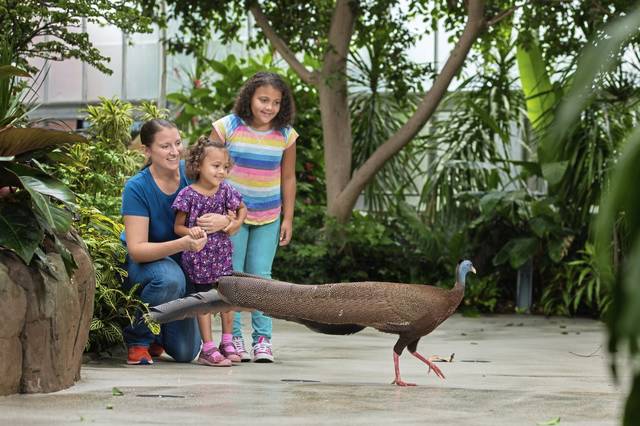https://triblive.com/mystory/fun-takes-flight-at-national-aviary-in-pittsburgh/
Fun takes flight at National Aviary

Call the National Aviary a major feather in Pittsburgh’s cap, so to speak.
Not only is it the nation’s largest aviary, but it’s also America’s only independent, indoor, nonprofit zoo dedicated exclusively to birds. And it’s the only one with honorary “national” status, conferred in 1993 by Congress.
The facility in the city’s North Side is home to more than 500 birds representing 150 species — including three species extinct in the wild: the Guam rail, Guam kingfisher and Edwards’s pheasant.
Other flutterers and tweeters in the aviary’s nine habitats are endangered in the wild, said Robin Weber, the aviary’s senior director of marketing and community relations. That includes the 20 African penguins found in Penguin Point, the aviary’s most popular exhibit.
Along with the penguins, the 185,000 or so annual visitors are particularly intrigued by the bald, golden, martial and Steller’s sea eagles; several owl species; and the brightly colored flamingos and parrots, Weber said.
Visitors also are invited to “lookie for Wookie,” a sloth that makes its home among the treetops of the tropical rain forest habitat. Wookie and two other sloths are the aviary’s only non-avian residents.
The slow-moving mammals are native to rain forests of Central and South America, Weber said.
“They spend most of their time in trees,” she said. “They spend their whole lives hanging upside down in the trees — they even give birth upside down.”
Weber said she often hears adults say that they haven’t visited the aviary since they were kids.
“Things are much different now, so it’s a great time to come back,” she said. “A major expansion in 2010 more than doubled its size.”
That expansion included the penguin habitat and the Helen M. Schmidt FliteZone Theater, the first and only indoor theater built exclusively for the presentation of live, free-flight bird shows.
The 125-seat theater offers two daily interactive experiences. The current program, “Amazing Amazon,” features birds and trainers, lights, music, video and opportunities for visitors to get up close and personal with some of the birds.
But there’s much more to the aviary than what visitors see.
“What visitors might not be aware of is the work that the National Aviary does behind the scenes” in the area of wildlife conservation, Weber says.
• Since the 1980s, the aviary has had a breeding program for rare and endangered birds. One result of that has been the reintroduction of the aforementioned Guam rail into the wild on two islands near Guam.
• The aviary has an avian medicine program that consults with programs at zoos and wildlife centers. Its procedures and protocols are used worldwide, Weber said.
• The aviary conducts field conservation and research programs in countries including the Dominican Republic, Ecuador and Costa Rica.
• The aviary’s education department provides programming to school groups and other groups.
“These are all things that are not readily visible but are very important,” Weber said.
The aviary has evolved from the late 19th-century origins as a plant conservatory, to which the City of Pittsburgh added birds during a 1952 rebuilding of the indoor gardens.
Hard financial times in the city and municipal budgetary cuts in 1991 threatened to close the aviary. Formation of Save the Aviary Inc., a private nonprofit corporation, led to privatization in 1992.
Supporters in private and public sectors campaigned for “national” status to give the aviary credibility while seeking funding, and a bill awarding that honorary status was signed by President Bill Clinton on Nov. 8, 1993.
Copyright ©2025— Trib Total Media, LLC (TribLIVE.com)
